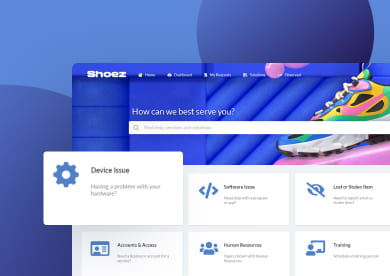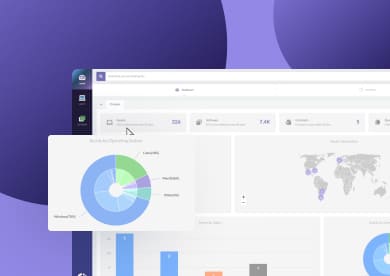Asset tracking is the practice of monitoring and managing an organization’s assets as they move through their lifecycle, from acquisition to retirement. The goal is simple: maximize asset value and the return on the investment (ROI) required to acquire, operate, and maintain them.
In this blog post, we’ll define asset tracking, outline its main applications, explain the technologies involved, and share a few practical examples. We’ll also cover the different types of asset tracking, while placing special focus on IT asset tracking.
What is asset tracking?
Asset tracking is the practice of identifying, monitoring, and managing an organization’s assets across their lifecycle, from acquisition to retirement. It shows where assets are, who has them, their status, and the value they deliver.
While you can track many asset types, in most business contexts "asset tracking" refers to physical assets, both IT and non-IT. Depending on the industry, that can include laptops and network equipment, tools and medical devices, delivery vehicles, or even heavy machinery.
Asset tracking in IT
IT asset tracking is the practice of identifying, monitoring, and managing an organization’s IT assets across their lifecycle.
In this case, it covers physical equipment such as laptops, desktops, servers, network devices, and peripherals, as well as digital assets like software licenses, SaaS subscriptions, and cloud entitlements.
Inventory tracking vs. asset tracking vs. Asset Management
Inventory tracking, asset tracking, and Asset Management are related, but they are not the same.
Asset tracking follows the long-lived items an organization uses to operate (laptops, vehicles, machinery), capturing location, custody, condition, and lifecycle status. Inventory tracking monitors goods a business buys, sells, or consumes (raw materials, finished products, supplies), focusing on quantities, stock movements, and reorder points.
Asset Management is broader. It governs the full lifecycle and strategy for assets, including planning, procurement, maintenance, compliance, costs, and end of life. Asset tracking feeds this discipline with accurate, operational data.
Why do you need to track assets?
Good decisions need good data. When you track assets properly, you get a reliable view of what you own, where it is, who uses it, and how it performs. That becomes a single source of truth for day-to-day operations and long-term planning.
IT asset tracking benefits
IT asset tracking has specific benefits. We’ve highlighted the five most important so you know what to expect:
- Real-time asset visibility: Keep a single source of truth for what you own, where each asset is, and who is responsible.
- Cost optimization and budgeting: Eliminate duplicate purchases, reduce idle stock, and plan refresh cycles with accurate forecasts.
- Security and compliance: Find vulnerable or missing devices fast, enforce standards, and pass audits with fewer surprises.
- License and SaaS optimization: Track usage, reclaim unused licenses, rightsize subscriptions, and avoid penalties.
- Lifecycle planning and ROI: Time procurement, upgrades, and disposition to extend asset life and recover value.
What types of IT assets should be tracked?
There are many types of IT assets you can track. Keep it simple. Focus on what you use, what you pay for, and what creates risk.
- Hardware: Includes laptops, desktops, servers, and network devices. Track each asset from purchase to disposal, including ownership, location, warranties, and service history — especially critical with distributed or remote teams.
- Software: Track licenses, usage, contracts, and renewal dates. Know what you’ve purchased, what’s actually in use, and stay ahead of audits, updates, and expirations to avoid unnecessary spend or risk.
- Cloud services: Monitor SaaS, virtual machines, cloud storage, and infrastructure subscriptions. Track usage, costs, roles, and SLAs to prevent surprise expenses and ensure vendor accountability.
- Consumables: Includes cables, keyboards, mice, and similar low-cost items. Use basic stock tracking and set reorder thresholds to avoid shortages and over-ordering.
- Specialized equipment: Covers industry-specific assets like medical devices, industrial machines, or lab tools. Track location, maintenance schedules, and compliance requirements due to high value and strict regulations.
“Every item you track should have their own story about how it supports your IT strategy and supports the bigger picture.”
Matt Beran, Product Specialist at InvGate
Asset tracking technologies to choose from
Choosing the right tracking technology depends on your assets, your environment, and your goals. Some methods are better for mobile fleets, others shine indoors, and some work best when paired with IT Asset Management software.
Here's a breakdown of the most common technologies used in asset tracking today.
#1: RFID asset tracking
RFID asset tracking uses radio waves to identify and locate tagged items without requiring direct line-of-sight. It's perfect for fast, automated tracking of high-value equipment, tools, and IT hardware.
Warehouses, hospitals, and construction firms often use it to speed up audits and reduce human error. Just keep in mind that setup costs can be high and signal interference is possible in some environments.
#2: Barcode labels and IT asset tagging
IT asset tagging with barcodes or metal tags is a classic, low-cost way to manage physical assets like laptops, monitors, or tools. It’s reliable, durable, and ideal for businesses that want to track location, maintenance, or ownership with minimal effort.
While scanning is manual and requires line-of-sight, it's easy to implement and works well across departments.
#3: GPS asset tracking
GPS asset tracking is the go-to solution for keeping tabs on mobile assets in real time. It’s commonly used in logistics, fleet management, and construction to monitor vehicles, containers, and equipment across large distances.
GPS is highly accurate, supports geofencing, and offers powerful security benefits—though it can generate a large amount of data to manage.
#4: IoT asset tracking
IoT asset tracking uses smart sensors to collect and transmit real-time data about an asset’s condition, movement, or usage. It’s ideal for businesses that need continuous insight — such as manufacturers, logistics providers, and healthcare facilities.
With IoT, you can monitor everything from temperature and vibration to asset health and performance, but you’ll need solid infrastructure and data management in place.
#5: QR codes
QR codes are a quick, low-cost way to access asset data using a smartphone or tablet. They’re commonly used for tracking IT equipment, tools, and office assets, especially in check-in/check-out systems.
QR codes don’t store much data on their own, but they provide instant access to cloud-based asset records and are easy to deploy across any team.
#6: Bluetooth Low Energy (BLE)
BLE beacons transmit low-energy signals to nearby receivers, making them great for indoor asset tracking.
They offer real-time asset location tracking for equipment in healthcare, retail, and warehousing environments. BLE is power-efficient and precise, but best suited for short-range coverage.
#7: Real-Time Location Systems (RTLS)
RTLS combines multiple technologies (RFID, Bluetooth, GPS, and Wi-Fi) to provide live tracking of assets within defined spaces like factories or hospitals.
It’s ideal for highly regulated environments that require tight control and full visibility. While powerful, RTLS systems are complex and expensive to deploy.
How to track IT assets in a company? Developing an asset tracking process

IT asset tracking isn’t just about knowing what you own — it’s about building an asset tracking program that supports growth, reduces loss, and improves decisions.
From spreadsheets to automated platforms, every organization starts somewhere. But to do it right, you need a structured, scalable process. Here's how to get started.
#1. Assess your current needs
Before jumping into a new tool, take stock of what’s working and what’s not. Are manual methods still enough? Do you need automation? This initial assessment will help define your scope and priorities.
#2. Choose the right asset tracking software
Outgrowing spreadsheets? Then it's time to invest in a dedicated IT asset tracking solution. The right software will help you reduce errors, streamline updates, and generate actionable reports.
#3. Build a comprehensive asset management database
Your database is the heart of your tracking strategy. Make sure it includes every critical asset — hardware, software, peripherals, and more — along with key details like user, location, and status.
#4. Select the right tracking technologies
Match your asset types with the right technology. For IT, that might mean automated discovery tools or QR codes. For mobile or industrial assets, GPS, RFID, or IoT sensors may be more effective.
#5. Maintain accurate asset records
Accuracy is everything. Each asset entry should include essential information such as serial number, assigned user, location, condition, and warranty. Keep records updated regularly.
#6. Establish tracking and maintenance workflows
Create clear processes for assigning, moving, maintaining, and retiring assets. These workflows ensure consistency and reduce the chances of things falling through the cracks.
#7. Conduct regular audits
Even with automation, periodic physical and digital audits are necessary to validate data, catch discrepancies, and ensure compliance with policies or regulations.
#8. Analyze data to optimize asset usage
Don’t just track — use the data. Identify underused assets, schedule preventive maintenance, and make informed decisions about purchases and replacements.
#9. Train employees on best practices
A system is only as strong as the people using it. Train your team on how to log, update, and report asset information correctly to maintain data integrity.
#10. Continuously improve your asset tracking strategy
As your organization evolves, so should your tracking strategy. Revisit processes, explore new technologies, and refine your workflows to stay efficient and scalable.
Asset tracking examples by industry
Asset tracking isn’t limited to one type of business. From hospitals to construction sites, these systems help improve efficiency, security, and decision-making across the board. Here are some of the most common use cases:
- Healthcare asset tracking: Monitor medical equipment and supplies to improve care and ensure compliance.
- Logistics and supply chain asset tracking: Track goods in transit to reduce delays and boost customer satisfaction.
- Construction asset tracking: Control tools and machinery across job sites to prevent theft and ensure availability.
- Manufacturing asset tracking: Manage raw materials and production assets to optimize processes and cut costs.
- Retail asset tracking: Track inventory and shipments to reduce shrinkage and prevent stockouts.
- Education asset tracking: Monitor laptops and devices to reduce losses and improve resource access.
- Transportation asset tracking: Track vehicles and cargo in real time to optimize routes, maintenance, and security.
- Government and defense asset tracking: Secure sensitive equipment and vehicles with technologies like RFID and GPS.
Using InvGate Asset Management as your asset tracking software

InvGate Asset Management gives organizations everything they need to track assets effectively, from building a complete inventory to monitoring health, usage, and costs in real time. It works as a comprehensive asset trackinf software. Here’s how it works:
#1: Build a complete asset inventory
InvGate collects asset data through multiple methods: manual or bulk uploads, installing the InvGate agent on devices, automatic network discovery, and integrations with other systems. This ensures you have a full, centralized view of every IT asset.
#2: Centralized asset tracking
With InvGate, you can track all types of assets in a single platform. This provides complete visibility into your ecosystem, supports IT asset tracking best practices, and helps decision-makers act on accurate, real-time information.
#3: Hardware asset tracking
Track hardware assets like computers and servers through the InvGate agent, which acts like an asset tracker that captures key details such as location, ownership, performance, costs, and depreciation. This allows IT teams to monitor asset health throughout the entire lifecycle.
#4: QR codes for asset tracking
For assets that can’t run the agent, InvGate lets you generate and print QR codes. By scanning them with the mobile app, you can instantly update and access asset details—perfect for peripherals, office equipment, or shared devices.
#5: Software asset tracking
InvGate tracks everything related to software, from license assignments and usage to cost and compliance. It can detect unsupported or unauthorized applications, automate uninstallations, enforce authorization policies, and even manage software deployment.
#6: Health rules
Define what a “healthy” asset looks like for your organization. With customizable health rules, you can automate alerts for missing antivirus, pending updates, associated tickets, or other conditions that need attention.
#7: Smart tags
Asset tracking tags are a key part of any asset tracking solution. Depending on the platform, they may go by different names. In InvGate Asset Management, we call them Smart tags, and they allow you to automatically group and label assets based on predefined conditions. Smart tags keep your inventory organized and make it easy to manage subsets of assets that share specific characteristics.
#8: Automated reports and dashboards
Generate scheduled reports and design real-time dashboards to monitor your assets. This keeps stakeholders informed and helps IT leaders identify trends, risks, and opportunities at a glance.
#9: Integrations
InvGate Asset Management integrates with a wide range of tools, including ITSM platforms like InvGate Service Management. This allows you to link requests with specific assets, improve troubleshooting, and strengthen collaboration between IT teams.
Connect our solutions with the apps you use every day.
Explore InvGate's integrations

The best part about InvGate Asset Management is that you can try it free with our 30-day trial. You can also talk to our sales team to learn exactly how we can meet your asset tracking needs.
4 best practices for asset tracking
Implementing asset tracking is one thing, but making it effective and sustainable requires discipline. Here are four best practices to keep in mind:
- Start with clear goals: Define what you want to achieve with asset tracking—whether it’s reducing losses, improving compliance, or optimizing costs. A clear objective will guide your process and technology choices.
- Standardize your data: Use consistent naming conventions, categories, and fields when recording asset details. Standardization keeps your inventory clean, reduces confusion, and ensures reports are accurate.
- Automate whenever possible: Manual methods don’t scale. Use an IT asset tracking system with discovery tools, smart tags, and automated reports to keep your data accurate without overwhelming your team. That's why automated asset tracking is a must.
- Audit and update regularly: Don’t let your inventory get stale. Schedule periodic audits and encourage employees to report changes, ensuring your records always reflect reality.















